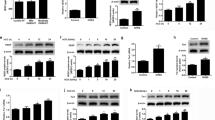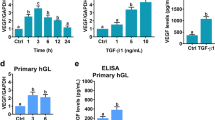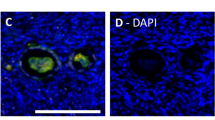Abstract
Follicle-stimulating hormone (FSH) is a pituitary glycoprotein that regulates follicle maturation through its binding to follicle-stimulating hormone receptor (FSHR). Endothelial cells express FSHR, but its exact role in endothelial cells remains unclear. Here we show that FSHR expression was detectable in human umbilical vein endothelial cells (HUVECs). FSH stimulation promoted HUVECs migration but not proliferation. Because FSHR is a GPCR, FSH treatment triggers the activation of cAMP-PKA signaling pathways, and the JAK-STAT, PI3K-AKT, and JNK-MAPK pathways. RNAi of FSHR dramatically attenuated the activation effect of FSH on HUVECs migration, as well as the related signaling pathways. Treatment of FSH in HUVECs also transcriptionally upregulated the expression of VAV3 and LAMA2, suppression either of VAV3 or LAMA2 by RNAi attenuated the FSH’s effect on HUVECs migration. All of these results indicated a functional role of FSH in the regulation of endothelial cells.
This is a preview of subscription content, access via your institution
Access options
Subscribe to this journal
Receive 12 print issues and online access
$259.00 per year
only $21.58 per issue
Buy this article
- Purchase on Springer Link
- Instant access to full article PDF
Prices may be subject to local taxes which are calculated during checkout





Similar content being viewed by others
References
Rice S, Elia A, Jawad Z, Pellatt L, Mason HD. Metformin inhibits follicle stimulating hormone (FSH) action in human granulosa cells: relevance to polycystic ovary syndrome. J Clin Endocrinol Metab. 2013;98:E1491–1500.
Sohn J, Ryu K, Sievert G, Jeoung M, Ji I, Ji TH. Follicle-stimulating hormone interacts with exoloop 3 of the receptor. J Biol Chem. 2002;277:50165–75.
Simoni M, Gromoll J, Nieschlag E. The follicle-stimulating hormone receptor: biochemistry, molecular biology, physiology, and pathophysiology. Endocr Rev. 1997;18:739–73.
Aittomäki K, Lucena JL, Pakarinen P, Sistonen P, Tapanainen J, Gromoll J, et al. Mutation in the follicle-stimulating hormone receptor gene causes hereditary hypergonadotropic ovarian failure. Cell. 1995;82:959–68.
Katari S, Wood-Trageser M, Jiang H, Kalynchuk H, Muzumdar R, Yatsenko SA, et al. Novel inactivating mutation of the FSH receptor in two siblings of indian origin with premature ovarian failure. J Clin Endocrinol Metab. 2015;100:2154–7.
Liu H, Xu X, Han T, Yan L, Cheng L, Qin Y, et al. A novel homozygous mutation in the FSHR gene is causative for primary ovarian insufficiency. Fertil Steril. 2017;108:1050–5.
Xie M, Li M, Zhou J, Ding X, Shao Y, Jing J, et al. Brain-derived neurotrophic factor promotes human granulosa-like tumor cell steroidogenesis and proliferation by activating the FSH receptor-mediated signaling pathway. Sci Rep. 2017;7:180.
Kong D, Guan Q, Li G, Xin W, Qi X, Guo Y, et al. Expression of FSHR in chondrocytes and the effect of FSH on chondrocytes. Biochem Biophys Res Commun. 2018;495:587–93.
Ponikwicka-Tyszko D, Chrusciel M, Stelmaszewska J, Bernaczyk P, Sztachelska M, Sidorkiewicz I, et al. Functional expression of FSH receptor in endometriotic lesions. J Clin Endocrinol Metab. 2016;101:2905–14.
Robin B, Planeix F, Sastre-Garau X, Pichon C, Olesen TK, Gogusev J, et al. Follicle-stimulating hormone receptor expression in endometriotic lesions and the associated vasculature. Reprod Sci. 2016;237:885–91.
Planeix F, Siraj MA, Bidard FC, Robin B, Pichon C, Sastre-Garau X, et al. Endothelial follicle-stimulating hormone receptor expression in invasive breast cancer and vascular remodeling at tumor periphery. J Exp Clin Cancer Res. 2015;34:12.
Pan B, Chen J, Lian J, Huang XF, Deng C. Unique effects of acute aripiprazole treatment on the dopamine D2 receptor downstream cAMP-PKA and Akt-GSK3ß signaling pathways in rats. PLoS One. 2015;10:e0132722.
Kenneth A. Jacobson. New paradigms in GPCR drug discovery. Biochem Pharmacol. 2015;98:541–55.
Stilley JA, Guan R, Duffy DM, Segaloff DL. Signaling through FSH receptors on human umbilical vein endothelial cells promotes angiogenesis. J Clin Endocrinol Metab. 2014;99:E813–E820.
Siraj A, Desestret V, Antoine M, Fromont G, Huerre M, Sanson M, et al. Expression of follicle-stimulating hormone receptor by the vascular endothelium in tumor metastases. BMC Cancer. 2013;13;246.
Sun L, Peng Y, Sharrow AC, Iqbal J, Zhang Z, Papachristou DJ, et al. FSH directly regulates bone mass. Cell. 2006;125:247–60.
Legg JA, Herbert JM, Clissold P, Bicknell R. Slits and roundabouts in cancer, tumour angiogenesis and endothelial cell migration. Angiogenesis. 2008;11:13–21.
Delgado VM, Nugnes LG, Colombo LL, Troncoso MF, Fernández MM, et al. Modulation of endothelial cell migration and angiogenesis: a novel function for the “tandem-repeat” lectin galectin-8. FASEB J. 2011;25:242–54.
Casarini L, Crépieux P, Reiter E, Lazzaretti C, Paradiso E, Rochira V, et al. FSH for the treatment of male infertility. Int J Mol Sci. 2020;21:2270.
Behre HM. Clinical Use of FSH in Male Infertility. Front. Endocrinol. 2019;10:322.
George AL, Rajoria S, Suriano R, Mittleman A, Tiwari RK. Hypoxia and estrogen are functionally equivalent in breast cancer-endothelial cell interdependence. Mol Cancer. 2012;11:80.
Acknowledgements
This project was supported by Hubei Province Health and family planning scientific research project (WJ2016-YZ-16) and 81501373 from National Science Foundation of China.
Author information
Authors and Affiliations
Corresponding authors
Ethics declarations
Conflict of interest
Authors state no conflict of interest. We would like to thank LetPub (www.letpub.com) for providing linguistic assistance during the preparation of this manuscript.
Additional information
Publisher’s note Springer Nature remains neutral with regard to jurisdictional claims in published maps and institutional affiliations.
Rights and permissions
About this article
Cite this article
Tan, D., Zhao, Y., Ma, D. et al. Role of FSH and FSH receptor on HUVECs migration. Gene Ther 28, 155–161 (2021). https://doi.org/10.1038/s41434-020-00195-w
Received:
Revised:
Accepted:
Published:
Issue Date:
DOI: https://doi.org/10.1038/s41434-020-00195-w



